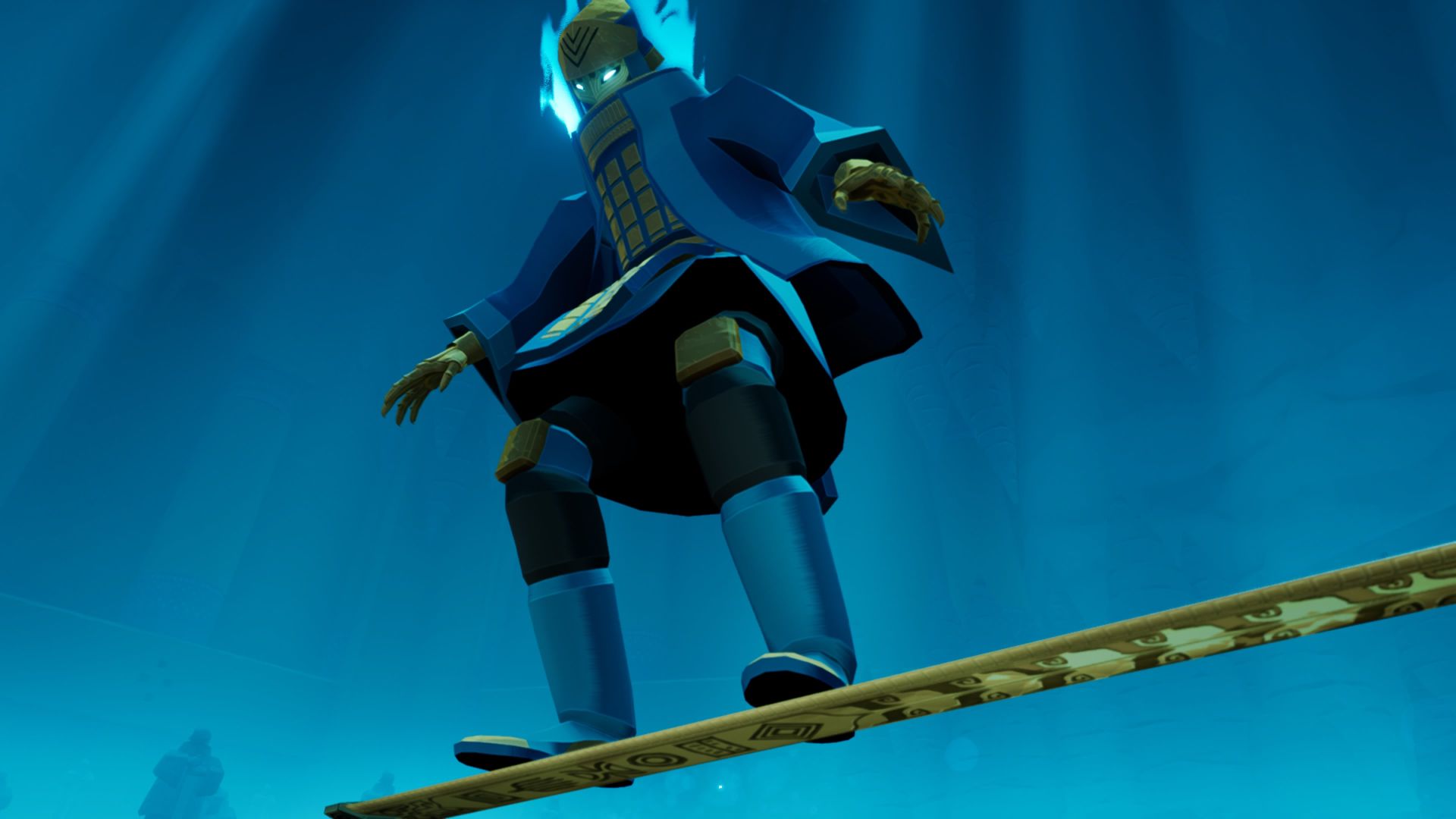There’s a persistent belief that in order for sharks to breathe underwater, they must keep on swimming. While this is partly true for a few species, the myth likely stems from how certain types of fishes (bony fish, if you want to know) need to breathe through constant motion, inhaling and pushing a huge amount of water through their gills as they swim. As the misconception goes, for sharks, much like their aquatic peers, to cease movement is to spell certain death — which is exactly how it feels playing Sword of the Sea.
The new game from Giant Squid scales this idea up by orchestrating movement into a grandiose, stirring symphony. Similar to the studio’s previous work — the underwater adventure Abzû — Sword of the Sea is an eco-fantasy about restoring the sea and its ecosystem in an arid landscape. Perched atop a sword, you surf across shifting dunes, leap toward dilapidated structures swallowed by sand, and unearth remnants of an ancient civilization that met its end in an unknown catastrophe.
The melody lifts as you backflip and perform ollies through this mural, with the music eventually soaring as you revitalize the landscape. You flit through the undulating contours of the seascape, the shoals now humming with new life. You spin in elegant arcs with the sea creatures that emerge, vaulting among the schools of fishes that make their unceasing journey toward the sky.
The seamless fluidity of movement in Sword of the Sea is deeply mesmerising. As a figure known only as the Wraith, you skate and flow through dunes and waves in search of ways to repopulate the barren desert with aquatic life. This can be done by completing simple puzzles, such as plunging your sword into craters or lighting up clusters of lanterns, which are typically found on higher grounds that you’ll need to perform acrobatic stunts to reach. That’s when emerald water and lush green grass will burst forth from these craters, with scores of fishes crashing through the dunes and floating jellyfish materializing with a pop, offering you access to previously unreachable heights.
Gliding through the freshly revitalized lands is even more exhilarating. Subsequent chapters include more ways to boost your movement to a thrilling degree, such as beacons for gliding across and glowing orbs you can collect to ramp up your speed.
Despite this focus on speed, the game doesn’t rush you to move on, even after restoring an area. Spending a few minutes nailing heel flips off the crests and troughs of the waves, and reveling in motion amid dense schools of fishes, is tantalizing. At the same time, you can seek and collect trinkets used to unlock new skateboarding tricks, like a double jump or kick flip. These are moves that you can string together — and put to the test — through optional timed puzzles.
This affinity the game has for kinetics, however, never supplants the sense of reverence it holds for the sea. The sea life isn’t just a resource or a means to a utilitarian end; you don’t simply hop on and steer the local fauna, such as orcas and turtles, toward the highest peaks or your next destination, although you can ride on them to enjoy a leisurely swim underwater. Other sea creatures, such as a dolphin and a shark, appear mythical and godlike, and you can later enlist their help in your expedition to traverse even greater distances. Sailing through the choppy waters with the aid of these majestic beings is particularly enchanting, as they jump over crumbling buildings and careen into towering crystals — feats you’ll never manage on your own.
Image: Giant Squid
These moments are accentuated by bright, cel-shaded aesthetics, which makes the ocean appear almost celestial and otherworldly. There’s also a symbiotic relationship between the Wraith and the sea life they’ve helped rehabilitate. Glowing algae, nesting at the edges of once-buried rooftops, helps you to jump higher, while tapestries of giant seaweeds allow you to float upstream, making your travel much more seamless. It’s a necessary reminder of how humanity plays a pivotal role in conservation efforts, and that we, in turn, can only benefit from the ocean’s well-being.
Sword of the Sea ratchets up the tension in its final chapters, leading to a climatic sequence that involves vanquishing the source of its calamity with breathtaking grace. It’s a fitting finale, but it also doesn’t mark the end. Instead, the game extends an invitation to redo your run again from the beginning, this time armed with a speedometer and a proposal to shave off more minutes, or even seconds, off your own record. It wants you to skate faster, jump higher, and plunge harder into the sea.
Not only is Sword of the Sea a celebration of the ocean, its love for unrestrained motion is also a metaphor for — and an homage to — the sheer vibrancy of underwater life. It’s an adventure I dove right into again, my skateboard surging with the pulse of the sea.
Sword of the Sea is available now on the PS5, Steam, and Epic Games Store.















